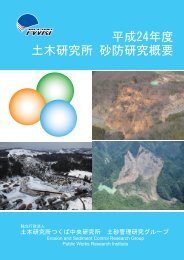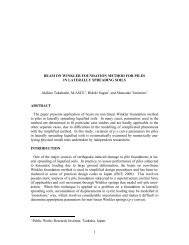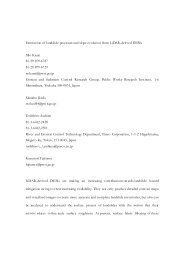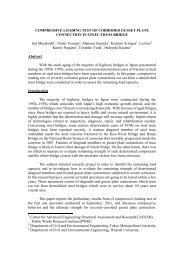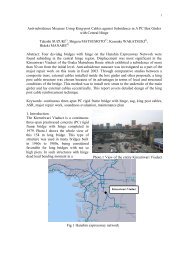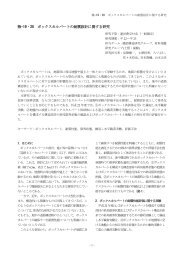SEATTLE'S SEISMIC RETROFIT PROGRAM David W. Korpi1 ...
SEATTLE'S SEISMIC RETROFIT PROGRAM David W. Korpi1 ...
SEATTLE'S SEISMIC RETROFIT PROGRAM David W. Korpi1 ...
You also want an ePaper? Increase the reach of your titles
YUMPU automatically turns print PDFs into web optimized ePapers that Google loves.
modified to include plastic hinges at the top and bottom of each bent column. The<br />
model was then pushed in the longitudinal (parallel to centerline of structure)<br />
direction to determine the longitudinal seismic displacement capacity. Each bent<br />
was also modeled as a stand-alone frame model and pushed in the transverse<br />
(normal to centerline of bridge) direction to determine the transverse seismic<br />
displacement capacity.<br />
• Mander's unconfined and confined concrete models (Ref. 6) were used to define<br />
the concrete stress-strain curves. Expected concrete compressive strength was<br />
equal to 1.50 times the specified 28-day concrete compressive strength (from the<br />
as-built plans). Unconfined concrete compressive strain at maximum compressive<br />
stress was taken as 2-microstrain. Ultimate unconfined concrete compression<br />
(spalling) strain was limited to 5-microstrain.<br />
• Park's model (Ref. 7) was used to define the reinforcing steel stress-strain curves.<br />
Strain hardening of the main reinforcing bars was accounted for. Expected<br />
reinforcing steel yield strength was equal to 1.10 times the yield strength (from<br />
the as-built plans). Where reinforcing bar development lengths did not meet the<br />
requirements of the FHWA Manual guidelines, the gross area of steel in the<br />
section was reduced by a ratio equal to the development length provided, divided<br />
by the development length required.<br />
• Member strength capacities were generally determined from the AASHTO LRFD<br />
code (Ref. 1), modified to exclude strength reduction factors and include ultimate<br />
strength characteristics. Shear and moment capacities of reinforced concrete<br />
sections in cross beams and foundations were calculated based on expected<br />
member properties. Column sections were analyzed using the software XTRACT<br />
which not only determines moment capacities, but additionally calculates<br />
curvature capacities, which were used in the push-over analysis.<br />
Individual items of the foundations, such as plinths, pile caps, and piles were analyzed as<br />
member capacities described above. Overall foundation rocking capacities were<br />
determined utilizing ultimate values of pile bearing capacity given in the Geotechnical<br />
Report.<br />
Section 7.8.2.7 of the FHWA Manual reads, “If the shear strength of the member<br />
is less than the shear demand (based on flexural strength) the plastic rotation will be<br />
limited. Two limiting cases are: (a) brittle shear, and (b) semi-ductile shear. These cases<br />
are based on the shear strength relative to the flexural strength.” (Ref. 4) When the<br />
initial shear strength of the member was less than the plastic shear demand, the member<br />
was considered to be ‘shear-critical’ and would fail in a brittle manner with no plastic<br />
rotation capacity. This type of failure was considered unacceptable unless the initial shear<br />
capacity of the member was sufficient to resist the seismic loads elastically. Otherwise,<br />
the member must be retrofitted to increase its shear capacity.<br />
When the plastic shear demand lies between the initial shear capacity and the final<br />
shear capacity of the member, the rotational capacity of the member was limited. If the<br />
238



